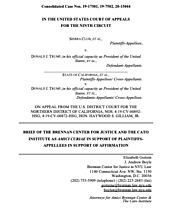Learn more about Cato’s Amicus Briefs Program.
The fight over the funding for President Trump’s border wall continues. In February 2019, shortly after President Trump declared a national emergency to divert funding to construct the border wall, the Sierra Club and the Southern Border Communities Coalition, represented by the ACLU, filed suit to block the action. Cato joined the Brennan Center on an amicus brief in support. Late last year the U.S. District Court for the Northern District of California partially ruled in favor the Sierra Club. Now on appeal to the Ninth Circuit, Cato is again teaming up with the Brennan Center on a brief in support.
Since the Constitution doesn’t provide the president with any explicit power to declare a national emergency, Congress passed the National Emergencies Act (“NEA”) in 1976 to ensure any use of so‐called “emergency powers” would be subject to strict congressional oversight. Congress wanted to provide the president with the necessary latitude to act in the event of a true nation‐wide emergency, so it purposely didn’t define the term “national emergency.” However, the law’s history makes it clear that Congress never intended to give the president wholly limitless power or discretion to declare national emergencies on a whim, let alone to allow the president to side‐step Congress to fund a specific project.
Having unsuccessfully lobbied Congress for two years to acquire funding for the wall along the southern border, President Donald Trump invoked the NEA and declared a state of national emergency to divert billions of dollars of appropriated federal funds to build a wall along the United States/Mexico border. The president issued an executive order citing a statutory provision that provides authorization and funding for military construction projects during emergencies that “require the use of the armed forces,” but only if the projects “are necessary to support such use of the armed forces” and meet the statutory definition of “military construction.”
In passing the NEA, Congress clearly intended for criteria like those to provide meaningful and enforceable checks on the president’s authority to issue emergency declarations. But the president’s invocation of the NEA fails to meet those criteria. For one, at the time of the declaration, there had been no sudden, unexpected change in illegal immigration at the southern border. Official government data puts illegal border crossings in 2017 at their lowest point in 46 years. There were also no significant, unexpected changes in patterns of crime or drug smuggling along the border. Second, it is clear from the president’s own actions that he did not believe the situation at the southern border merited “immediate action.” For the first two years of his administration, he accepted Congress’s decision not to provide border wall funding with little pushback. Lacking the political will to acquire funding through the legislative process, the president now seeks what amounts to an unconstitutional end run around Congress’s constitutional authority to appropriate federal funds.
The president’s emergency declaration to build a wall along the southern border is a sharp departure from past practice. Without judicial intervention, it has the potential to create an extraordinarily dangerous precedent, effectively giving the go‐ahead for future presidents—of any party or political stripe—to invoke emergency powers to address routine or politically charged policy problems, or even use those powers to take actions for which Congress has expressly withheld consent. Would President Elizabeth Warren declare a national emergency of gun violence, as she has essentially said she would? Would President Bernie Sanders declare a national emergency in health care, perhaps arguing that unhealthy citizens impair the military? Any of these actions, like President Trump’s would be clearly inconsistent with NEA’s intent and allow the executive branch to side‐step the legislative branch in order to achieve its policy goals, effectively upsetting the balance of power between the president and Congress.

This work is licensed under a Creative Commons Attribution-NonCommercial-ShareAlike 4.0 International License.
